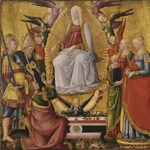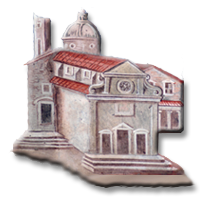Introduzione
Main panel of an altarpiece from San Michele, Prato, finished in 1467; the predella is in the Museu Nacional d'Art de Catalunya, Barcelona (64972)
The apostle Thomas, who is often called Doubting Thomas because he refused to believe in the Resurrection of Christ until he had touched Christ's wounds, also doubted the Virgin's Assumption. This panel shows the Virgin Mary lowering her belt to Thomas from Heaven to convince him that she has been lifted there after her death.
The panel comes from an altarpiece commissioned by the abbess of the convent of San Michele in Prato, near Florence. She chose this story because a relic thought to be the Virgin's belt was preserved in the principal church of Prato.
The Virgin, seated on small clouds in a rayed mandorla surrounded by eleven angels, hands her belt to the apostle Thomas. Red roses and white lilies fill her empty tomb below.1
To the left are Saints Michael Archangel and Augustine. Michael is shown as a young soldier standing on a vanquished serpent that represents Lucifer, whom Michael, as standard bearer of the heavenly host, drove out of heaven.2 Although Michael does not have wings, the triangular violet headdress denotes his angelic status. Augustine wears a black habit as well as a bishop's cope and miter.
To the right are Saints Margaret of Antioch and Catherine of Alexandria. Standing on a dragon, Margaret holds a book and a cross because she once made the sign of the cross to drive away a dragon that sought to devour her. Catherine of Alexandria wears a crown and holds a martyr's palm and a book. She stands on the spiked wheel that broke while her pagan tormentors were using it to torture her.
The central episode of Saint Thomas receiving the Virgin's belt is apocryphal. According to a popular account given by Jacopo da Varazze in The Golden Legend of about 1267-77 (Ryan and Ripperger ed. 1941, p. 454), Thomas was absent at the Assumption of the Virgin and, therefore, did not believe it took place. "But suddenly the girdle wherewith her body had been begirt fell unopened into his hands, that so he might understand that she had been assumed entire." Although Jacopo da Varazze emphasized the doubtful nature of the story,3 and a contemporary of Neri di Bicci, the Florentine archbishop Antonino, railed against paintings of the subject,4 its popularity in the fifteenth century remained unabated.
Neri di Bicci described the painting in an entry in his Ricordanze (1453-75, Santi ed. 1976, pp. 304-5), dated September 4, 1467:
The Altarpiece of San Michele of Prato: I record that on the above-mentioned day, September 4, 1467, I consigned an altarpiece made and shaped like a square in the antique style, about 3 1/2 braccia [76" (193 cm)] long and 3 2/3 braccia[115" (292 cm)] high, in which was painted an Assumption of Our Lady with many angels and at the bottom Saint Thomas and to her right Saint Michael and Augustine and to her left Saint Margaret and Saint Catherine and in the predella three stories with other figures, all on a background of fine gold and worked with good and fine colors, which was commissioned to me by madonna Francesca, abbess of San Michele of Prato, and in the said and for the said church the contract was made for the said painting, which I took on to execute for her some time ago, for which, according to the agreement, she must give me 200 lire in the following manner; that is 47 lire, equal to the value of 10fiorini larghi, were given to me before May 15, 1467, in four parts, as is recorded in my account book marked E on pages 121-122, and the remaining sum, which is 143 lire, must be paid to me in the next three years, to be made every year on the fourth of September, in installments of 47 lire, 13 soldi, 4 denari, beginning September 4, 1468, and as was agreed upon with Ser Guaspare di . . . , the Florentine notary, the said day, in the place of and in the name of the said madonna Francesca, his sister, and these same pacts I made concerning the above-mentioned 200 lire with madonna Francesca when I took on the said painting. Having been given . . . lire received at various times and occasions as is in the account book marked D on page. . . . To book D. on page 167.5
San Michele of Prato was a monastery of Benedictine nuns who observed the Augustinian rule. The archangel was included in the altarpiece because he was the titular of the church, and Saint Augustine was shown because he was said to have written the rule the nuns observed. Saints Margaret and Catherine were much venerated in such female monastic communities. The episode of the apostle Thomas receiving the Virgin's girdle had particular significance for Prato, where the Sacro Cingolo, or Holy Belt, was preserved in the city's main church, then the collegiata. The nuns of San Michele seem to have had a particularly close connection to this cult through their sister convent of San Martino, just outside Prato, which in 1426 had been joined to San Michele. San Martino owned the polyptych by Bernardo Daddi (q.v.) once in the chapel of the Sacro Cingolo in Prato. Its now-lost main panel probably showed the same scene as Neri di Bicci's painting. The altarpiece was sold back to the collegiata in 1438, but the predella, now in the Museo Civico, depicting the story of the relic's arrival in Prato after the First Crusade, was left behind.6
The relic was similarly the object of much veneration in the convent of Santa Margherita of Prato, where the painter Filippo Lippi was chaplain. Sometime in the early 1460s his workshop painted for its abbess Bartolomea de'Bovacchiesi an altarpiece of the Assumption and saints (see Prato, Museo Civico, no. 28) that is almost identical in composition to the Neri di Bicci panel and that in fact may have provided a model for it.7
In the Ricordanze Neri di Bicci mentions that the San Michele altarpiece (Main panel: see Philadelphia Museum of Art, John G. Johnson Collection cat. 27; predella: see Barcelona, Museu Nacional d'Art de Catalunya, no. 64972) had a predella with "three stories with other figures." One fitting this description exists in the Museu Nacional d'Art de Catalunya in Barcelona (see Barcelona, Museu Nacional d'Art de Catalunya, no. 64972). It shows the Fall of the Rebel Angels, which relates to Saint Michael; the Dormition of the Virgin, which is the event that occurs just before the Virgin gives Thomas her belt; and Saint Catherine of Alexandria at the wheel, who is also depicted at the far right in the main panel. At either end of the predella are kneeling nuns; to the left a single nun, probably the abbess Francesca, is being presented by Saint Lawrence, and to the right two nuns are being presented by an unidentified female saint. Although the predella is 14 1/8" (35.9 cm) longer than the Johnson panel, the difference would have been made up by framing elements and possibly also by lateral pilasters. Furthermore, in Neri di Bicci's altarpieces, the predella tends to be considerably longer than the main panel.8
The nineteenth-century Pratese historian Giovanni Pierallini thought that Neri di Bicci's altarpiece for San Michele had been taken from the church in the 1790s by Napoleonic troops and never returned.9 In the early twentieth century the predella was with the Parisian dealer Ludovico de Spiridon. We do not know from whom John G. Johnson bought his panel, but as it was in his collection before 1905, when F. Mason Perkins published it, it may have also once been with Spiridon, who by that point had sold Johnson many old master pictures.
Neri di Bicci's description of the altarpiece as "in the antique style" is a reference to its contemporary Renaissance format in which the figures are shown in a uniform, rectangular picture field. Despite this, the figure style is conservative and recalls the largely curvilinear motifs of International Gothic painting, with which Neri and his patrons were most comfortable. The artist did not describe the frame in detail, but most likely it would have been made up of classicizing architectural elements.
The basic form of combining a central narrative scene with standing figures of saints is one that Neri repeated in several altarpieces, including a number in which Saint Thomas is shown receiving the Virgin's belt. Neri's patron at San Michele, Francesca, may have been familiar with one of them.10 Closest to the Johnson panel in composition and date is theAssumption of the Virgin with Saint Thomas and Saints Peter, Jerome, Francis of Assisi, and John the Baptist in the church of San Leonardo in Arcetri, Florence (see Florence, church of San Leonardo in Arcetri), which Neri painted for Bernardo Salviati and his wife, Mona India, a little over a month before he consigned the altarpiece to San Michele.11 The Salviati commission was first recorded on June 1, 1467; Neri finished the work on August 11. The basic formula is the same as in the Johnson panel, although the latter is bigger, its gilding is more richly tooled, and its angels are greater in number. The Virgin and Thomas as well as the sarcophagus are obviously based on the same cartoons. The panel for the Salviati painting cost only 110 lire and 14 soldi, as opposed to the 200 lire paid for the San Michele panel. Because in hisRicordanze Neri wrote that he "took on to execute the San Michele altarpiece some time ago" and that the first payment was made on May 15, 1467, it was likely begun before the Salviati commission, and the speed with which the latter was executed may have depended on the ready availability of the cartoons from the San Michele altarpiece.12 Neri's subsequent altarpieces of the same subject likewise depend on variations of the same cartoons.13 Carl Brandon Strehlke, from Italian paintings, 1250-1450, in the John G. Johnson Collection and the Philadelphia Museum of Art, 2004, pp. 327-332.
Notes:
1. The red roses signify the troops of martyrs and the white lilies represent the hosts of angels, confessors, and virgins (Iacopo da Varazze. The Golden Legend. Translated and adapted from the Latin by Granger Ryan and Helmut Ripperger. 2 pts. London, 1941, p. 452).
2. The archangel's presence at the Virgin's Assumption is significant. According to The Golden Legend, three days after the Virgin's burial, Christ asked his apostles what honor he should convey on his mother; they replied that he should raise her body and place her at his right hand. When Christ assented, Saint Michael appeared and presented the Virgin's soul to him (Iacopo da Varazze. The Golden Legend. Translated and adapted from the Latin by Granger Ryan and Helmut Ripperger. 2 pts. London, 1941, p. 454).
3. As evidence he cited a letter in which Saint Jerome wrote, "many other things are set down therein an apocryphal book attributed to John the Evangelist rather as symbol than as fact, as for instance that Thomas was absent and refused to believe when he arrived, and other like things, which manifestly are to be left aside rather than believed" (Iacopo da Varazze. The Golden Legend. Translated and adapted from the Latin by Granger Ryan and Helmut Ripperger. 2 pts. London, 1941, p. 454).
4. In his Summa theologica (c. 1446-59) Antonino wrote, "But neither are they to be praised when they paint apocrypha, such as midwives at the Virgin's delivery, or her girdle being sent down by the Virgin Mary in her Assumption to the Apostle Thomas on account of his doubt, and the like" (quoted in Creighton Gilbert. "The Archbishop on the Painters of Florence, 1450." The Art Bulletin (New York), vol. 41, no. 1 (March 1959), p. 76).
5. "Tavola di San Michele di Prato: Richordo ch'el sopradetto di 4 di setenbre 1467 rendeì una tavola d'altare fatta e formata quadra al'anticha, di braccia 3 1/2 per.lla largheza e braccia 3 2/3 per.lla alteza incircha, nella quale era dipinto una Asunzione di Nostra Donna cho molti angioli e da pie' San Tomaso e da mano destra Santo Michele e Aghostino e da mano sinistra Santa Margherita e Santa Chaterina e nella predella 3 istorie chon altre fighure, mesa tuta d'oro fine e.llavorata di buoni e fini cholori, la quale m'aloghò a fare madonna Francescha badessa di San Michele di Prato e in detta e per detta chiesa fa fare la detta tavola, la quale tolsì a fare più tenpo fa da lei, della quale mi de' dare d'achordo 1. dugento in questo modo, cioè 1. quarantasette per.lla valuta di f. 10 larghi mi dèttono insino a dì 15 di magio 1467 in 4 partite, chome a mia entrata segniato E a c. 121-22 e resto che sono l. 143 mi debono dare in tre anni prosimi a venire ogni anno a dì 4 di setenbre l. 47 s. 13 d. 4 inchominciando a dì 4 di setenbre 1468 a chosì d'achordo fatto chon ser Ghuaspare di . . .notaio fiorentino el detto dì in vece e nome di detta madonna Francescha sua sirochia e questi medesimi patti feci cholla sopradetta l. 200 madonna Francescha e quando tolsì la detta tavola. Annone dato l. . . . auti in più tenpi e in più volte chome a libro D a c. . . . . A libro D a c. 167" (Florence, Biblioteca degli Uffizi, Manoscritti 2, folio 129 recto).
6. For the predella (nos. 1-5), see Richard Offner with Klara Steinweg, continued under the direction of Miklós Boskovits and Mina Gregori. A Critical and Historical Corpus of Florentine Painting. Sec. 3, vol. 3, The Fourteenth Century: The Works of Bernardo Daddi, by Richard Offner. New edition by Miklós Boskovits with Enrica Neri Lusanna. Florence, 1989, pp. 212-21, plate xi.
7. Jeffery Ruda. Fra Filippo Lippi: Life and Work with a Complete Catalogue. London, 1993, p. 465.
8. A photograph (Florence, Soprintendenza Speciale per il Polo Museale Fiorentino, Gabinetto Fotografico, neg. no. 14459 v.n.) of Neri di Bicci's Coronation of the Virgin altarpiece, without its frame, in San Giovanni dei Cavalieri di Malta in Florence, shows how the predella was made wider than the main picture to support both it and the frame.
9. Pierallini (Giovanni Pierallini. "Monastero di San Michele." Pel calendario pratese del 1850: memorie e studi di cose patrie (Prato), vol. 5 (1849), p. 155) learned of the altarpiece from a selection of the Ricordanze published in 1849 in the second volume of Vasari, edited by Vincenzo Marchese and the Milanesi brothers, Carlo and Gaetano, and issued by the Le Monnier publishing house (Giorgio Vasari. Le vite de' più eccellenti pittori, scultori e architetti. Edited by Vincenzo Marchese, Carlo and Gaetano Milanesi. vol. 2. Raccolta artistica. Florence, 1846, p. 243).
10. The first was made for the Spini family's chapel in Santa Trinita in Florence and delivered on August 28, 1456. It is now in the National Gallery of Canada in Ottawa (no. 3716; Myron Laskin, Jr., and Michael Pantazzi. Catalogue of the National Gallery of Canada, Ottawa: European and American Painting, Sculpture, and Decorative Arts, 1300-1800. 2 vols. Ottawa, 1987, fig. 9). It was larger than the San Michele altarpiece, at 6 by 5 braccia (130 x 108" [331 x 276 cm]) and contained more figures--all twelve apostles. This probably accounts for its greater price of 480 lire. In the Ottawa painting, Saint Thomas has the unusual position of kneeling on the edge of the Virgin's tomb. In 1463 Neri consigned another altarpiece for the sacristy of the monastery of Camaldoli (Neri di Bicci. Le ricordanze (10 Marzo 1453-24 Aprile 1475). Edited by Bruno Santi. Pisa, 1976, pp. 187-88, no. 372). This cost 33 florins, or approximately 181 lire, with the frame subcontracted to Giuliano da Maiano for 6 florins. The altarpiece is lost or has not been identified. The next year Neri painted a similar altarpiece, with Saints John the Baptist, Nicholas of Bari, Julian, Francis, and Jerome, for the since-destroyed church of Santa Maria degli Ughi, Florence. It measured 5 by 4 braccia (108 x 86 5/8" [276 x 220 cm]) and cost 271 lire and 8 soldi. The painting is now in the State Pushkin Museum of Fine Arts in Moscow (no. 24; Moscow, State Pushkin Museum of Fine Arts. Catalogue of Painting (in English and Russian). Moscow, 1995, p. 107).
11. Neri di Bicci. Le ricordanze (10 Marzo 1453-24 Aprile 1475). Edited by Bruno Santi. Pisa, 1976, no. 567, pp. 299-300.
12. The figures in the Salviati altarpiece are approximately 3 7/8" (10 cm) shorter than those in the Johnson altarpiece.
13. They are the Assumption with Saint Thomas and Saints Benedict, John the Baptist, Peter, Paul, Augustine, and Romauld (1467; Bagno di Romagna, church of Santa Maria del Fiore); and the Assumption with Saint Thomas and Saints John the Baptist and Bartholomew (1470-75; San Miniato al Tedesco, Museo Diocesano d'Arte Sacra; Gigetta Dalli Regoli, ed. Il "Maestro di San Miniato": lo stato degli studi, i problemi, le riposte della filologia. Introduction by Federico Zeri. Texts by Serenella Castri, Gemma Landolfi, and Paola Richetti. Pisa, 1988, figs. 19-26 [color and black-and-white]). At least two variants of the latter by Neri di Bicci exist; the Assumption with Saint Thomas and Saints Mary Magdalene and Catherine of Alexandria (present location unknown; last recorded in the collection of Marchese Ippolito Venturi Ginori; Florence, Kunsthistorisches Institut, photograph nos. 35957, 83715); and the Assumption with Saints Mary Magdalene and Catherine of Alexandria (Seville, Casa de las Dueñas; photograph at the Fototeca Berenson, Villa I Tatti, The Harvard University Center for Italian Renaissance Studies, Florence).
Fonte: www.philamuseum.org



